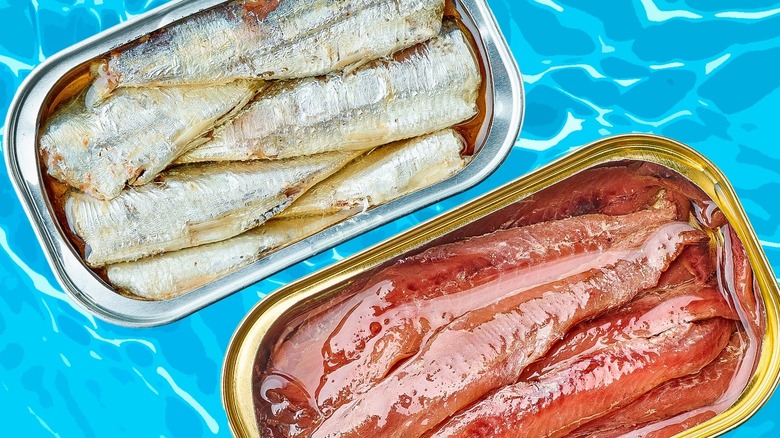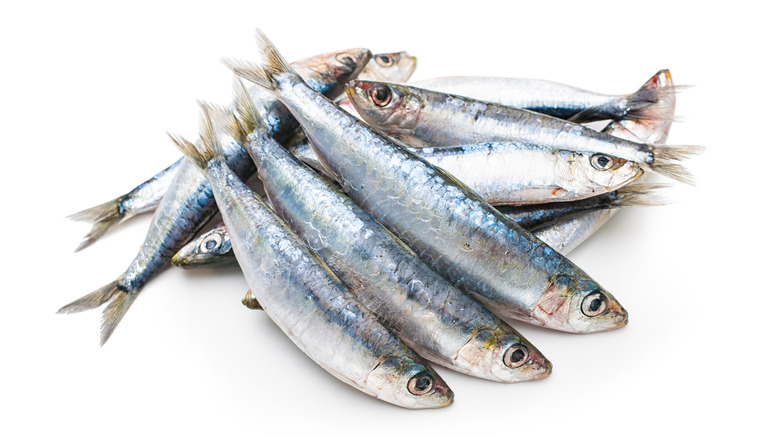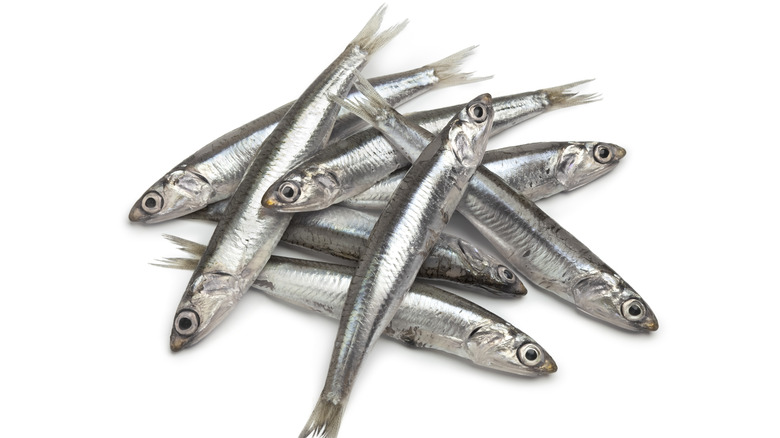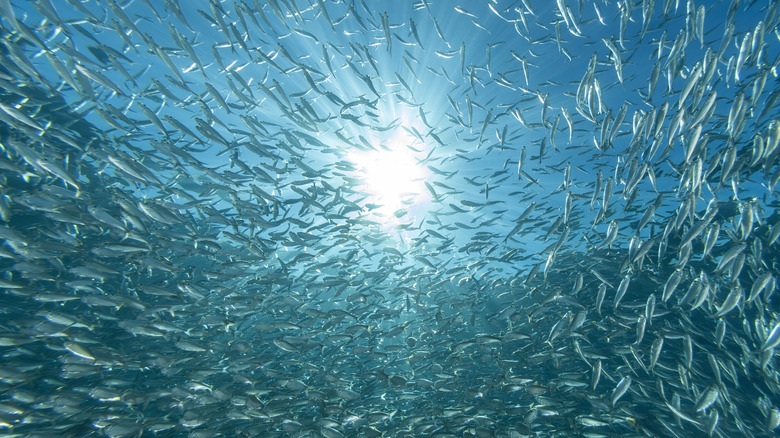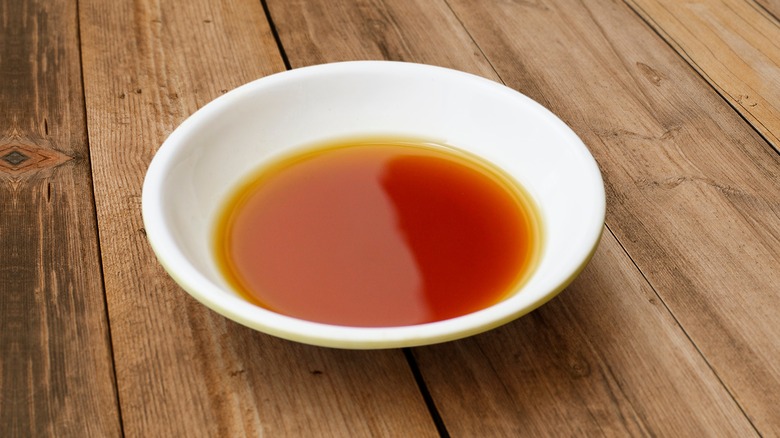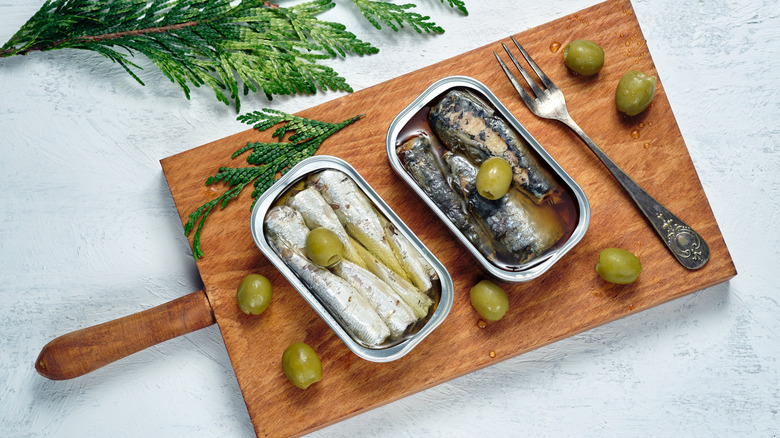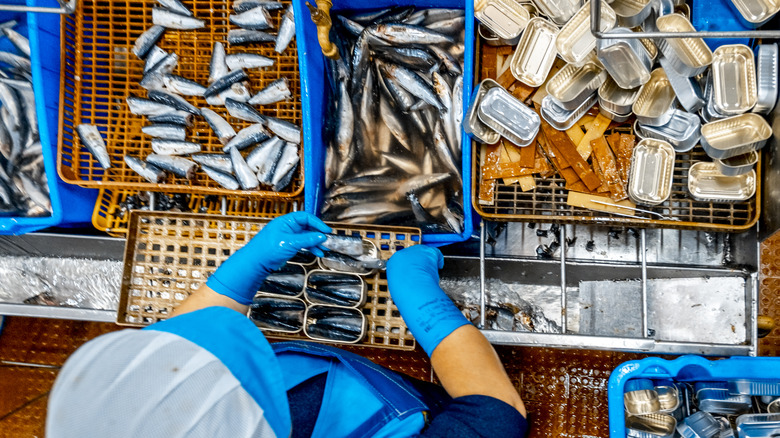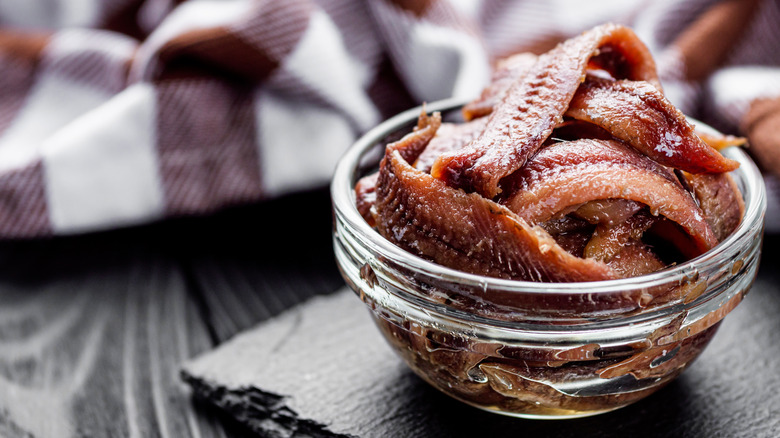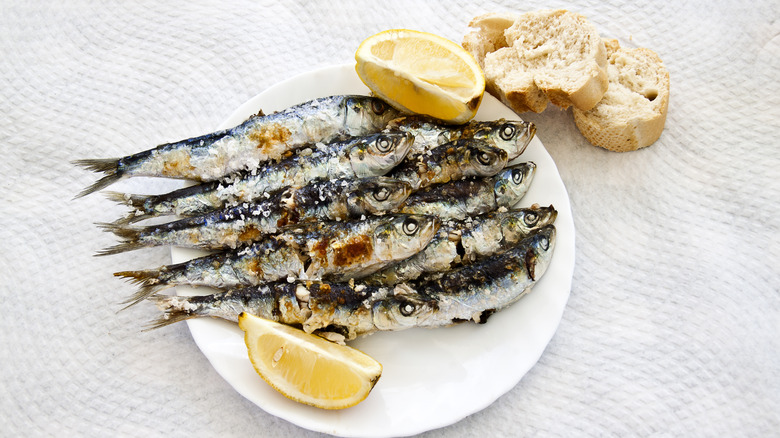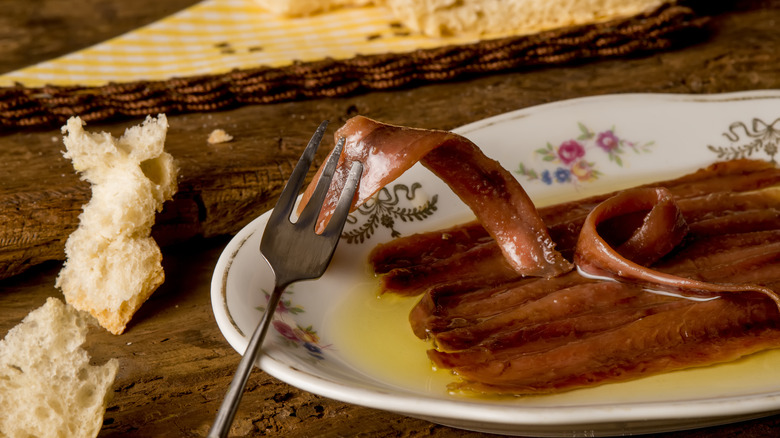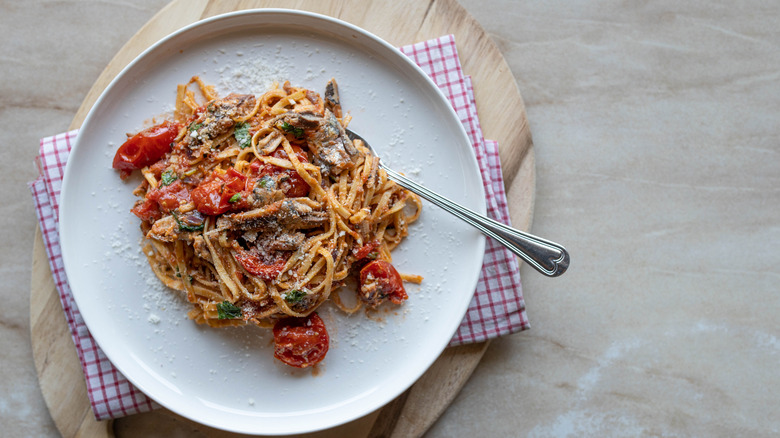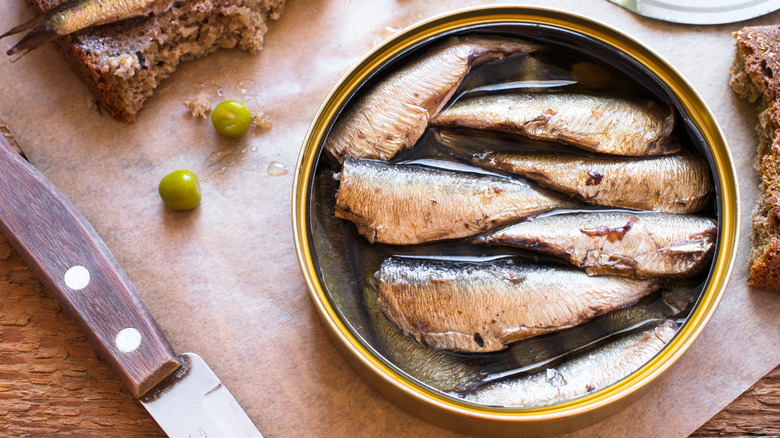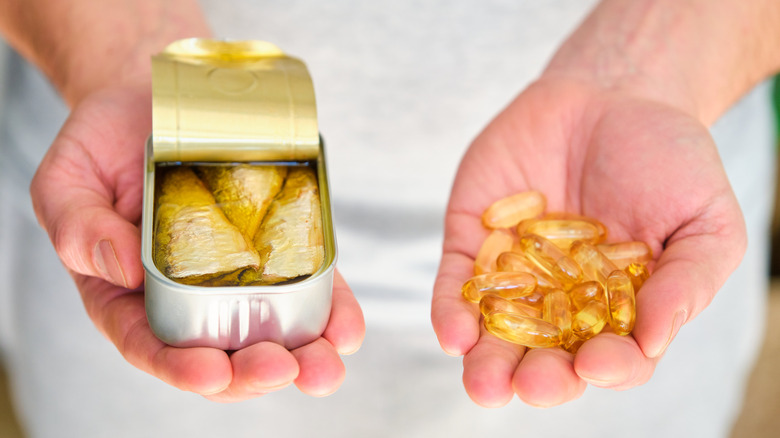Sardines Vs Anchovies: What's The Difference?
To a seafood novice, anchovies and sardines may seem like the same thing. They have a similar slender body and belong to the category of oily fish that's abundant and widely distributed in oceans and seas. Another thing they have in common is that the majority of sardines and anchovies that we eat come in tin cans. This often confuses people, and they immediately assume it's a variation of the same thing that can be used interchangeably.
In reality, they are two different fish species with different characteristics and culinary uses. Learning the difference between anchovies and sardines is important for those who want to cook with them and those who will only see them on the menu. The two don't deliver the same qualities. They're used for different purposes and, in most cases, make significantly different dishes.
As TikTok recently fueled the popularity of tinned fish and made consumers more aware of their convenience and nutritive benefits, it's necessary to debunk some common myths and misconceptions about these popular products. Get informed on the differences, so you can choose, buy, and eat better.
Sardines have more in common with herring
Sardines are usually described as small, elongated fish that are mainly caught and used as food. Though we often assume that this is a single fish variety, the nomenclature is slightly confusing as there are several fish species that are often referred to as sardines. They fall within the Clupeidae family, which includes herrings, shads, and menhadens, meaning that sardines are more related to herrings than anchovies, which belong to a whole different family of fish.
The best-known variety is Clupea pilchardus, which you will sometimes see referenced as European sardine or true sardine, while the Brits like to call it pilchard. This sardine is found in the Mediterranean and the North Atlantic, usually around Spain, Portugal, and Great Britain. Sardinops sagax, or Pacific sardine, is another important variety that inhabits vast areas in the Pacific and Indian Ocean, while the Sardinella genus includes numerous varieties found in the Atlantic, Pacific, and Indian Oceans.
The term sardine has been adopted around the world, and while some countries have uniform labeling systems for canned sardines, others are not particularly restrictive, so the only way to truly know what is in the can is to look for the back label and the Latin name of the species.
The term anchovy can refer to over 100 species
Anchovies are small, elongated fish that represent an important food source for humans and many marine animals. Just like sardines, they belong to the Clupeiformes order, but fall into a different suborder. The classification of anchovies is less vague as they all belong to the same Engraulidae family, but it gets equally complicated as the family consists of 17 genera that count over 140 varieties that are all commonly referred to as anchovies.
One of the most important varieties is the Engraulis encrasicolus, better known as the European anchovy. This variety inhabits the Mediterranean, the Black Sea, the North Sea, and the Atlantic, and it's one of the most common options for curing and canning due to its firm body and fillets that can hold structure after processing.
Other commercially important varieties include the Japanese anchovy from the Western Pacific, the Californian (Northern) anchovy found between British Columbia and Baja California, and the South African anchovy caught in the seas of southern and eastern Africa. Peruvian anchoveta is a variety heavily sourced in the southeastern Pacific. Though it's suitable and used for human consumption, most of it is used as animal feed.
They look different and like different environments
They may be different species, but sardines and anchovies do share many similarities. Both are mainly saltwater fish widely distributed around the world that live in large school groups and feed on plankton. However, they differ in appearance and prefer slightly different habitats.
As there are many varieties, not all sardines are identical, and they often vary in size from six to 12 inches in length. Their slender bodies are covered in scales that create a shiny, silvery surface hue. They have one dorsal fin and a lower-positioned jaw. Raw sardines have darker flesh that usually turns white with processing. Aside from one species found only in the Philippines, sardines are to saltwater and prefer temperate habitats.
Anchovies are generally smaller than sardines, typically reaching five to six inches. Though there are differences between the family members, most have a longer snout and a wide jaw, with the upper jaw extending behind their eyes. Their silvery bodies are covered in small scales. Anchovies prefer warmer environments and are often found in brackish estuaries, and sometimes in freshwater. When canned, their flesh usually gains a distinctive reddish color.
Anchovies have been preserved and enjoyed since the Roman times
Though we can't say when anchovies were first used as food, we know that ancient Romans loved using them in their diet. This tiny fish was commonly salted and fermented and then made into a pungent sauce they used to call garum. Historians believe this type of fish sauce first originated in Greece but was later adopted and perfected by the Romans. Though we mainly talk about one type of fish sauce, Romans most likely had at least two versions made with different fish and techniques, resulting in sauces that varied in flavor and intensity. The sauce was mostly used as a savory condiment and is often colloquially referenced as Roman ketchup.
Though mass production of this fish sauce stopped after the fall of the Roman Empire, the tradition was not entirely forgotten, and Italians still produce a contemporary version similar to the original. This modern version of anchovy sauce is called colatura di alici, which literally translates as "anchovy drippings." The process follows a simple technique of salting anchovies and allowing them to ferment and age. A byproduct of the process is an umami-laden liquid that's bottled and sold as a condiment. Though the sauce is not produced on a larger scale, there are several available labels that you can buy and use as any fish sauce.
Sardines were popularized with the invention of canning
Sardines have been enjoyed since ancient times. An abundant fish, many maritime countries used it as food, as evident in traditional dishes enjoyed around the world. It's often said that sardines were named after Sardinia, a large island in the Mediterranean Sea, but this theory could never be confirmed as the Greeks already used the terms sardine, sardinos, and sarde, and it's not likely that they traveled the distance to Sardinia to catch fish. Though the first records of eating sardines are not well documented, this silvery fish became incredibly popular after the invention of canning.
The need for canning arose in the 18th century and was first initiated by France, which offered a prize to anyone who would think of the best and most economical way to preserve food other than the standard pickling or drying. Nicolas Appert was the first to develop a patent in 1809, using sealed glass jars. His invention was upgraded by Peter Durand, an Englishman who used tins as a more convenient packaging. Seafood was one of the first canned foods. As a highly perishable product, it was ideal for canning as it allowed people to eat seafood further inland.
Sardines were a top contender for canning, and the first tins were packed in 1834 in Nantes, France, which fueled their popularity and expansion. Despite fluctuations over the years, sardines are still one of the most common canned fish, and their popularity is expected to grow.
Both fish are great for canning, but they are processed differently
Anchovies and sardines are some of our favorite fish to eat from a tin, but they don't use the same preservation method to get to the tin, which affects the taste, texture, and final appearance. The process of canning sardines starts with freshly caught fish that needs to be delivered to the factory as soon as possible. The fish is then graded and sorted, based on size and quality, before it's thoroughly cleaned. The next step is to wash the fish and steam or blanch it. This removes excess moisture and ensures that flesh remains firm and does not fall apart. The fish is then canned in brine, olive oil, or tomato sauce, occasionally with spices and veggies. Producers can choose whether to can the whole fish, remove the head, or just pack fillets. Once sealed, the cans are sterilized and chilled.
Processing anchovies also starts with fresh fish that's distributed to the factories. Workers then salt it, remove the heads and guts, and leave the fish to rest layered with sea salt. After several months — though some producers opt for longer curing — the fish will lose some moisture, and it'll be time to wash off the salt, remove the bones and the skin, pack the fillets in tins, and douse them in oil. Though we mainly talk about tins, anchovies are also frequently packaged in glass jars.
They taste different
As sardines and anchovies are different fish species that are usually processed differently, you can't expect them to have the same flavors. With sardines, the flavor will mainly depend on the processing technique. Freshly cooked sardines have soft, tender, and often flaky meat with a mild flavor that does not come off as too briny or fishy. Canned sardines have similar qualities, but the meat can be slightly softer, and the taste, depending on the processing, can be a bit stronger than what you'd find in fresh varieties. The flavor of canned sardines will also depend on the canning liquid and whether the fish has been skinned. Overall, sardines are not too pungent or overpowering and are an easy and affordable way to incorporate more fish into your diet.
Anchovies are a different story. As the oil or salt-cured version is the one you'll mostly come across, expect strong flavors from this tiny fish. Though it's difficult to precisely illustrate their complex taste, you can expect a medley of savory, salty, and earthy flavors and an umami quality that can be transformative in various dishes. Anchovy flavor probably won't agree with everyone, but some will love and appreciate its robust character and pungent kick. Preserved anchovies will usually have a very soft texture that easily breaks apart. Spanish-style anchovies preserved in vinegar are another popular variety, with a subtly acidic and slightly milder flavor. You can easily recognize them for their distinctive white color.
Sardines are often sold and cooked fresh
Due to their long shelf life, nutritional value, and great flavor, canned sardines are deservingly popular. Plus, they can be used in a variety of ways, whether it's adding sardines to pasta dishes, to salads or sandwiches, or just eaten as is, preferably with a drizzle of olive oil and bread on the side. Despite the benefits, let's not forget that sardines are commonly sold and cooked fresh.
Fresh sardines are wonderfully versatile and can be grilled, fried, roasted, or even smoked. If you're buying them on the market, you might want to ask the fishmonger to clean them for you, or if you're not squeamish, you can easily clean them at home. Make sure to remove the scales, the gut, and, optionally, the head. For the fried version, dip the sardines in seasoned flour and let them crisp up in oil. Grilled sardines are amazingly flavorful, as the smokiness pairs nicely with the buttery flesh. They are best grilled whole, preferably smothered with oil, and later served drizzled with lemon juice. If you have a demanding crowd to feed, you can remove the head, fillet the whole fish, and then grill or fry it so it can be eaten whole.
Unlike sardines, anchovies are not commonly sold fresh and are mainly available in locations with direct access to the sea. These fish are difficult to transport, but are ideal for curing and preservation.
Anchovies are a great sidekick in recipes
Unlike sardines, which are typically the star of the show, you should look at anchovies as an accompaniment and an umami-packed sidekick that will easily upgrade any dish. This tiny fish is big on flavor, so remember that a little goes a long way when using oil or salt-cured anchovies.
If you're not sure where to start, look for inspiration from traditional dishes. Classic Caesar salad uses an anchovy-based dressing that can be replicated or tweaked for various green leafy salads. Italian bagna càuda is a mouth-watering sauce that partners anchovies, garlic, and olive oil. It's served hot and makes a fantastic dipping sauce during aperitivo hour. Anchovies are also much-appreciated in spreads and French-style tapenades. Other than that, these fish can make a mean pasta sauce, the best known being pasta puttanesca, an Italian classic with tomatoes and olives. Add anchovies to your meat or fish marinades, and watch your classic dishes become genuine gourmet affairs.
Of course, layering a whole anchovy on top of bruschetta or pizza is an option for all die-hard fans of this salty fish. If you're serving them whole, make sure to get the best quality. You want the flavor to be spot on.
You can't always swap them in recipes
If you're cooking with anchovies or sardines, it's crucial to know the difference between them, as the two are not interchangeable, and swapping them in recipes is generally not recommended. The main reason not to do this is the flavor profile. If the recipe suggests sardines, switching them with anchovies will significantly impact flavor. Though the dish will get more complexity and depth, you will end with an overpowering, heavily salty dish. Swapping anchovies with sardines could potentially work, but you would probably have to increase the amount of salt. The result will miss the umami kick and probably only resemble the original.
Texture is another important factor. Fresh and canned sardines are meatier and have a good chew, while anchovies easily break down and melt if cooked longer, so they can't significantly impact the texture. Overall, it's best not to swap the two. Use mackerel or a similar type of canned fish instead of sardines, and try swapping anchovies with similar umami-laden ingredients such as Southeast Asian fish sauces or Worcestershire sauce.
If you're working with fresh anchovies or sardines, you can usually use them interchangeably, as they can be fried, grilled, or roasted. Of course, expect a slightly different flavor and more meat with sardines.
Both sardines and anchovies are packed with nutrients, vitamins, and minerals
Despite many differences, sardines and anchovies have similar nutritional profiles, and both are excellent food choices as they pack various nutrients, vitamins, and minerals. Keep in mind that the calorie count and the profile change, depending on whether you're using fresh or tinned versions.
Four medium-sized fresh sardines pack around 180 calories. Though they are high in cholesterol, they also pack more than 28 grams of protein, zero carbs, and a minuscule amount of sodium. By comparison, fresh anchovies have around 150 calories and are also high in cholesterol, low in sodium, and a great source of protein. Sardines canned in oil keep a good nutritional profile, coming up to just over 190 calories per 3.75-ounce can, and don't lose the good characteristics. Oil-cured anchovies are similar, with one can (2 ounces) having around 100 calories. It should be noted that this version is high in sodium, which could be problematic for people with high blood pressure or other heart-related problems.
Sardines are an excellent source of vitamins D and B12, selenium, and phosphorus, while anchovies pack a lot of selenium and niacin. Both fish are also beneficial due to the high amount of omega-3 fatty acids that are usually recommended as a great option to fight inflammatory processes and generally keep the heart healthy and help the brain work better.
You should be swapping red meat with anchovies and sardines
Besides other classifications, sardines and anchovies also fall into the category of forage fish, a group that includes all species that feed on plankton and get eaten by bigger fish, mammals, and birds. Forage fish are crucial for the normal functioning of the ecosystem, but it seems they might directly help us live much healthier lives too.
Research published in BMJ Global Health concluded that eating forage fish instead of red meat can effectively prevent diet-related illnesses. Red meat is notorious for contributing to the growing number of coronary diseases, and it seems that forage fish would be a great alternative to keep them from happening, essentially saving up to 750,00 lives a year by 2050. The main reason why forage fish is a much better option is due to the high amount of omega-3 fatty acids these fish contain.
The study also concluded that forage fish has the lowest carbon footprint compared to other animal-based foods. So, if you ever needed a hint and a motivation to eat more sardines and anchovies, this is it.
